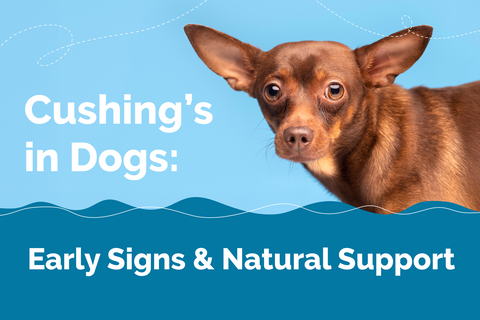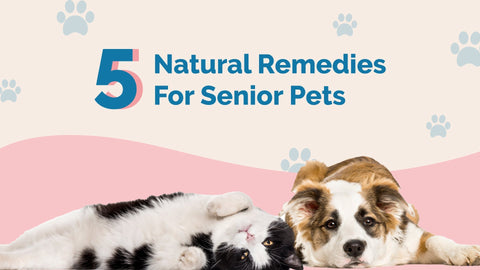

Cushing’s Disease Symptoms Checklist: What to Watch For
At Prana Pets, we believe in Natural Wellness, Unconditional Love, and solutions Backed by Science—so you can support your pup with confidence. Cushing’s (canine hyperadrenocorticism) can look like “just old age,” but a careful eye and a simple plan make a big difference.
This Cushing’s disease symptoms checklist explains what’s happening with the hormone cortisol, which signs to track, how vets confirm the diagnosis of Cushing, and where natural support can fit alongside your veterinarian’s care. We’ll keep it plain-English, actionable, and hopeful—because your best friend deserves comfort and clarity. 💚
Cushing’s, Simplified (What the Pituitary & Adrenal Glands Are Doing)
Cushing’s occurs when the adrenal glands produce too much cortisol for a long time. In most cases, a tiny pituitary adenoma (a benign pituitary tumor at the base of the brain) drives excess adrenocorticotropic hormone (ACTH), which then pushes the adrenals to overwork—this is called pituitary-dependent disease, the most common form. Less commonly, an adrenal tumor makes cortisol on its own (adrenal-dependent). Either way, the result is chronic over-production of cortisol, which affects skin, muscle, thirst, appetite, and even blood pressure. Vets focus on overall health and tailored treatment options to reduce signs while keeping quality of life high.
The Scannable Cushing’s Disease Symptoms Checklist ✅
These are the signs of Cushing’s disease most pet parents notice first. If you’re checking multiple boxes, book a chat with your vet.
-
Excessive thirst & urination (water bowls emptying fast, more potty trips).
-
Increased appetite and weight gain or rapid weight gain (still hungry after meals).
-
Pot-bellied appearance (weakened core muscles + fat redistribution).
-
Thinning skin & hair loss (slow wound healing; coat looks dull/brittle).
-
Panting or restlessness even when it’s cool and quiet.
-
Reduced energy & weakness (shorter walks, hesitant stairs, stiff gait).
-
Skin infections, bruising, calcinosis cutis (weakened defenses).
-
Behavior shifts (night wakings, pacing), occasional high blood pressure readings, and elevated blood sugar in some cases.
Expert quote — Dr. E. Behrend (ACVIM consensus): “Endocrine tests should be performed only when clinical signs consistent with hyperadrenocorticism are present…none of the screening or differentiating tests are perfect.”
Articleproducts1
How Vets Confirm the Diagnosis (Plain-English Testing Roadmap)
Vets start with history, physical exam, and blood tests, then move to endocrine testing. The low-dose dexamethasone suppression test (LDDST) is widely considered the screening test of choice because of its sensitivity; the ACTH stimulation test also plays a role, especially when certain conditions are present. After confirming too-high blood cortisol level, additional tests help tell pituitary-dependent from adrenal-dependent disease—think endogenous ACTH measurement and abdominal ultrasound. The goal is a confident diagnosis of Cushing that guides safe, effective treatment of Cushing and monitoring.
Testing quick hits:
-
LDDST → great screening test; may hint at type.
-
ACTH stim → also used; helpful in some scenarios.
-
Endogenous ACTH → higher suggests pituitary-dependent; very low suggests adrenal tumor.
-
Ultrasound → looks at adrenal size/shape to support the plan.
Fast Answers for Pet Parents:
How do Cushing’s syndrome symptoms differ from other similar conditions?
Cushing’s can mimic hypothyroidism, diabetes, or just “getting older.” What stands out is the combination: big thirst/urination, increased appetite, pot-belly, thin skin, and slow wound healing—plus classic lab changes tied to cortisol. Vets rule out look-alikes with targeted tests so your dog gets the right therapy.
Which early warning signs are most often overlooked?
Owners often chalk up more thirst, more panting, and “a little belly” to age. Subtle coat thinning, recurrent skin infections, and reduced stamina also slip under the radar. When these cluster, ask your vet about screening; earlier action means faster comfort.
Is there a symptoms checklist I can use?
Yes—use the checklist below before your appointment to provide a better panorama to your Vet. For clinic-grade summaries, your vet may share ACVIM or Merck Veterinary Manual handouts that cover signs, blood tests, and the dexamethasone suppression test/ ACTH workflow.
Cushing’s Symptoms Checklist 📝
-
Excessive thirst & urination (dates/notes): ________
-
Increased appetite / unexplained weight gain: ________
-
Pot-bellied appearance / reduced stamina: ________
-
Hair loss / thin skin / slow wound healing: ________
-
Panting at rest / restlessness: ________
-
Recurrent skin infections / bruising: ________
-
Any blood pressure changes or blood sugar spikes: ________
-
Medications or steroid medicines currently used: ________
-
Questions for the vet (LDDST, ACTH stim, endogenous ACTH, ultrasound): ________
Articleproducts2
How Prana Pets Supplements Can Help
We believe in natural support that works with your dog’s body rather than against it. Two of our most trusted supplements for dogs showing signs of Cushing’s are the Adrenal & Lignans Combo and Mobility & Coat Care Chews.
Adrenal and Lignans Combo
The Adrenal and Lignans Combo bundle includes Adrenal Balance plus our Lignans & Melatonin Blend, which together help promote balanced adrenal function.
-
Adrenal Balance: An herbal formula designed to support healthy adrenal gland function and hormone regulation.
-
Lignans & Melatonin Blend: Lignans are phytoestrogens that help balance hormone levels, while melatonin can reduce excess cortisol. Together, they provide targeted support for dogs with Cushing’s symptoms.
This combo is especially useful for dogs experiencing hair loss, thinning skin, or increased thirst and appetite.
Mobility & Coat Care Chews
Cushing’s disease can take a toll on joints and coat health. These Mobility & Coat Care soft chews provide joint support and improve skin and coat condition.
-
Glucosamine & Chondroitin: Promote joint lubrication and flexibility, helping dogs with stiffness or weakness.
-
Omega Fatty Acids: Support skin health and restore shine to the coat.
-
Antioxidants & Vitamins: Protect cells and promote overall vitality.
For dogs dealing with pot belly, stiffness, and dull coats, these chews offer relief and long-term support.
Natural Support Benefits for Dogs with Cushing’s
By combining adrenal support with mobility and coat care, pet parents can help their dogs feel more comfortable and energetic. Benefits may include:
-
Balanced hormone function
-
Improved energy levels
-
Healthier skin & thicker coat
-
Reduced stiffness and better mobility
-
Stronger immune function
Care Plan Basics You Can Start Today (Simple, Steady, Kind) 🙂
Small, consistent habits help dogs feel better—even while you and your vet fine-tune therapy.
-
Diet & body condition: Choose balanced calories; aim to slow unexplained weight gain.
-
Gentle exercise: Short, sniff-rich walks maintain muscle without over-fatigue.
-
Hydration: Fresh water always; track intake if thirst surges.
-
Routine vet visits: Regular blood tests and physical exam refine the plan and watch for side effects.
-
Stress reduction: Predictable schedules + enrichment = calmer days (better skin and sleep).
Articleproducts3
Sidebar: “Cushing’s” vs “Cushing’s Syndrome” vs “Cushing Disease” (Terms You’ll Hear)
-
Cushing’s syndrome = the broader term for excess cortisol from any cause
-
Cushing disease = a pituitary tumor (often micro) is the driver.
-
Hyperadrenocorticism = veterinary synonym you’ll see in records.
Your vet will clarify which type applies; that directs the treatment of Cushing and monitoring.
When to Call the Vet (Green-Light vs Red-Flag Moments)
Call your veterinarian if you notice extra cortisol clues stacking up: increased thirst/urination, belly changes, thinning coat, or behavior shifts. Seek prompt care if there’s vomiting, collapse, extreme lethargy, or suspected drug interactions. Early teamwork prevents complications like infections, high blood pressure, or secondary health problems that build over a long time.
Final Thoughts (The Prana Pets Way)
Cushing’s can feel complicated—but you’re not alone. With careful observation, a vet-led plan, and gentle natural support, your dog can enjoy brighter, calmer days. At Prana Pets, we craft solutions that respect the whole pup—body, mind, and bond—so you can focus on the moments that matter. Explore the Adrenal & Lignans Combo and Mobility & Coat Care Chews to round out your routine, and partner with your veterinarian for safe, steady progress. Here’s to comfort, wiggles, and more good days ahead. 💚
articlebanners1




